The first strategy game I seriously played and loved was Dune II: Battle for Arrakis. Before that, I was absolutely not interested in this genre. I never found it particularly exciting to virtually push some combat units around on a map. But Dune 2 nevertheless cast its spell on me and has not let go of many of us to this day. A whole bunch of successors poured over the audience in the years that followed. However, these clones soon lost the appeal of the new. Perhaps I would have found these fresh ideas in other – less well-known – representatives of the genre back then. In search of such pearls, I enter the famous hexa fields of The Perfect General II.
The game begins with a short intro in which 3D-animated tanks flex their muscles on the battlefield. Already at this point, pacifist-minded people are more likely to be put off than excited. Afterwards, the player is greeted by a military man who announces the winning strategy for a particular battle in (English) voice-over.

You then have the choice of playing either a complete campaign or a single mission. The four campaigns are each dedicated to a specific historical theme and divided into a handful of different scenarios. Ideally, however, you will have memorised the name of the battle in the intro and can try out the suggested strategy directly in the corresponding individual mission.
However, this presupposes that one has already mastered the complete mechanics of the game and does not need any further explanation. Apparently, the required knowledge has to be taken from the manual beforehand. A tutorial would have been of great benefit to the newcomer here. Otherwise, a short explanatory description and a look at the map help to decide on one of the almost 90 scenarios.
The player is offered a whole range of war settings, each emphasising quite different perspectives. For example, there are historical references (Stalingrad, Iraq War, Vietnam War), special strategic situations (two-front war, guerrilla warfare) or the influence of the weather (river freezes during the battle, fog obscures the view).

In addition to the given scenario, there is often a specific event in the course of the mission. Typically, this is the arrival of supplies after an intermediate objective has been reached.
In addition to the geographical starting position, the player then determines whether he wants to enter the battlefield as defender or attacker. This different basic strategic orientation between two rival parties can also favour the course of the game one-sidedly. That is why, by default, the opponents compete against each other twice and switch positions the second time. In order to determine a winner, the game automatically calculates a score at the end of each round. The attacker usually has few points in the first turns because his attack is still developing and the cities are defended tenaciously by the defender. Holding these areas earns the owner a number of points per round, depending on the importance of the city in question. Through progressive conquests, the attacker gains the chance to equalise the initially high point reserves of the opponent by acting quickly and finally to catch up by capturing as much land as possible. In the options, the number of game turns can be set at the beginning. This results in an advantage for the attacker in the case of a long game with many turns and for the defender in the case of a short game.
At the end of a battle, the player earns a military title depending on his score. The Perfect General is the highest rank, which is almost impossible to achieve. In addition, statistical evaluations of the winning points are displayed during the course of the battle. To complete a successful mission, the player should not only keep an eye on the geographical starting position and the basic strategic alignment. The selection of troops at the beginning of the game is also crucial. For even the best general is of no use with unsuitable troops. For this purpose, the player has a mission-dependent budget at his disposal and can use it to buy infantry, vehicles, tanks, artillery and aircrafts. A further subdivision into light, medium and heavy has a corresponding influence on the price. Depending on the type, the combat units differ in characteristics such as speed, armour and effectiveness.
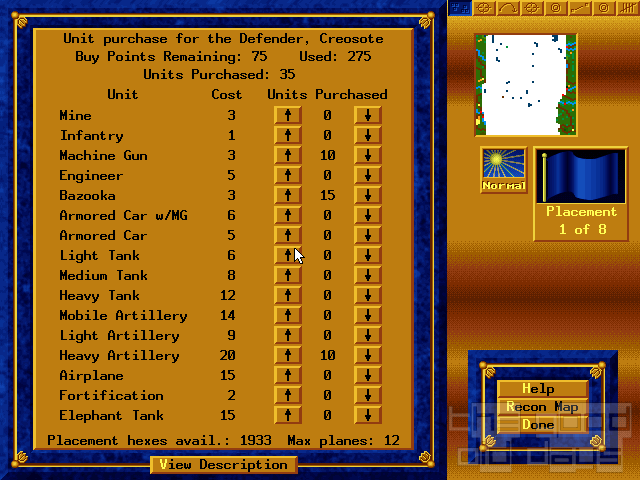
The infantry is by far the cheapest and can form a whole company in terms of numbers. But the enemy can simply roll over the troops with only one tank. From this point of view, the expensive tank offers a high destructive power. To prevent this, the ground troops can be equipped with a bazooka. This turns them into real tank busters. The use of artillery is also double-edged. Without good visibility, it has only a very limited field of action. If it gets too close to the enemy, it can easily come under fire itself. In order to make practical use of the range, one should know the terrain very well and make good use of elevations and hills in particular.
It is important for the movement and transport of troops to use paths, roads and tracks which are marked on the map. This is because cross-country travel is extremely cumbersome, especially for armoured vehicles. Therefore, exposed waypoints such as bridges, crossroads and forest clearings are also important strategic objectives in addition to the actual cities. These can, for example, be kept under constant fire with favourably positioned mobile artillery.
Independently of this, the player may also use aircraft and in this case should have a runway to which they can return after the attack. They are also particularly expensive, only fly on sunny weather and can themselves be shot down relatively easily. It is nice that planes have been considered. But their influence on the outcome of a battle is only marginal. I would have preferred ships from the navy.
In this context, ground troops called “engineers” are also worth mentioning. These have certain mission-dependent abilities such as building bridges or laying mines. But even this special feature is only a nice addition and remains virtually without any real gameplay-relevant effect.
The purchased units are now placed on the playing field in a predefined zone and only now does the actual gameplay begin. A game consists of about 20 turns, which are divided into several combat phases. Roughly speaking, these consist of setting the targets for the artillery fire, the alternating fire of the ground forces and the issuing of the further direction of march for each individual unit.
Each phase is passed through by both the attacker and the defender. The moves of the computer opponent are displayed in real time. The options offer different running speeds for this. But beware: On slow PCs, this phase leads to agonisingly long waiting times, even with a short time limit. The vehicles then only move across the playing field at a snail's pace. Firing at a moving enemy unit that comes into the line of fire during such a phase requires the quick clicking of a fire button that lights up red. In order to concentrate fully on the strategic part of the game, you can switch off partial damage with the “Full Kill” option and even exclude missing the target with “Always Hit”. Then this fire button becomes a one hundred percent killer button.
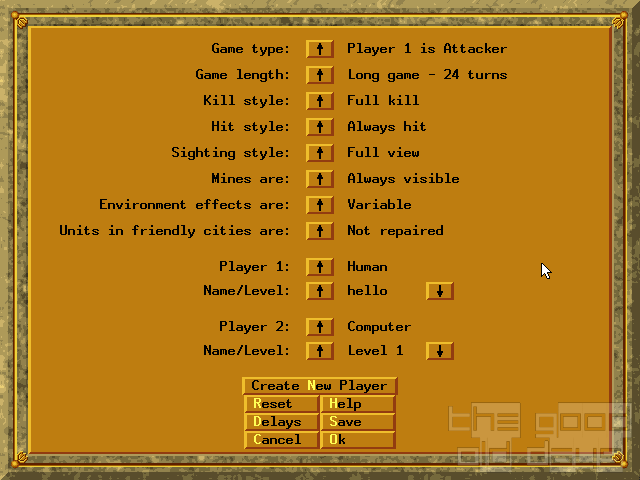
After the exchange of fire, the movement of the army now takes up the major part of the entire gameplay. This is because each unit must be moved individually, since multiple selection is not possible. Typically, you start with about 50 units. These are placed on the playing field with 50 mouse clicks, and after another 50 mouse clicks the directions for the first turn are just given. That already tried my patience a lot. On top of that, however, the nearest vehicle is not automatically pre-selected after the movement. Instead, the focus jumps somewhere else according to an internal sequence. Then you have to scroll back again, mark the desired vehicle with another mouse click and finally set the desired new position. Mind you, this procedure is the main part of the actual gameplay. But that's not all. On top of that, there is another nerve killer: In the not infrequent case that the target hex is already occupied by another unit in the hectic of battle, a bloodcurdling squawking sound comes from the loudspeaker. The player who has been reprimanded in this unpleasant way may then move the vehicles manually. This is not at all easy on the exclusively single-lane roads.
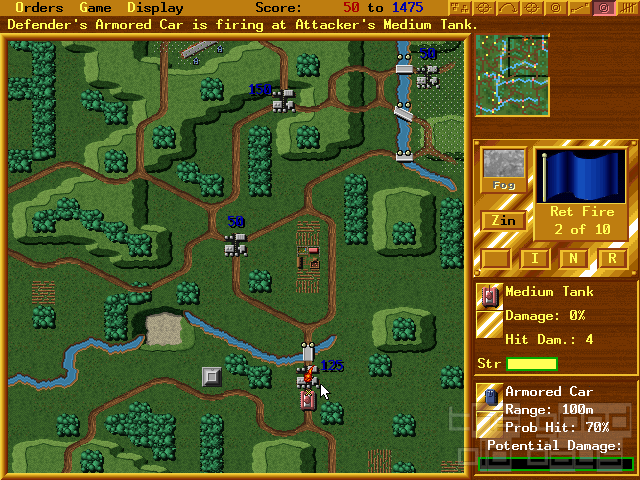
Fortunately, the sound is otherwise rather modest. Every now and then there is a muzzle flash or a bombardment sound. A short background music sounds without a loop on the menu level. The graphics are also rather modest. The only animation on a map is water moving slightly up and down in lakes or rivers. The cities look like an ugly mesh of grey-black areas. Some of the game level is more comic style, while other scenarios have a more realistic touch. In fog and especially in snow, however, the areas generally become very confusing. The ground troops are rather unimaginatively symbolised only by a flag. In addition to the meagre two-level zoom, there is a very coarse overview map in the upper right corner that is far too small. The desire for a stepless zoom sounds like blasphemy. Savings are also made in the maximum length of the player's name. With only 8 characters, I was unfortunately unable to choose a suitable name such as Ironbreaker, Steelhammer or I-am-eating-rusty-nails-for-breakfast.
I would call the underlying principle of attack and defence the real innovation. The success of the game came with the implementation of this idea for competition between human opponents. Several technical implementations were integrated for this purpose: Hot Seat, Null Modem, Modem and LAN. And to this day, The Perfect General II is one of the few games that has an active online community. Once the initial hurdle has been overcome, the game offers an incredible wealth of tactical finesse. Even one of the more than 80 maps can be an exhausting playground for ever new intricacies and strategies, especially in 2-player mode. The computer AI keeps up easily and is not only strong at level 5. Therefore, even on level 1, a sense of achievement only comes with deeper understanding and a corresponding pinch of luck.
Will the interested player put up with the fiddly micromanagement and the bland presentation? For my part, I only won one battle as an attacker, which according to the mission description is as easy as a walk in the park. Strategically speaking, victory was indeed easy and the main task was to endlessly click on units.
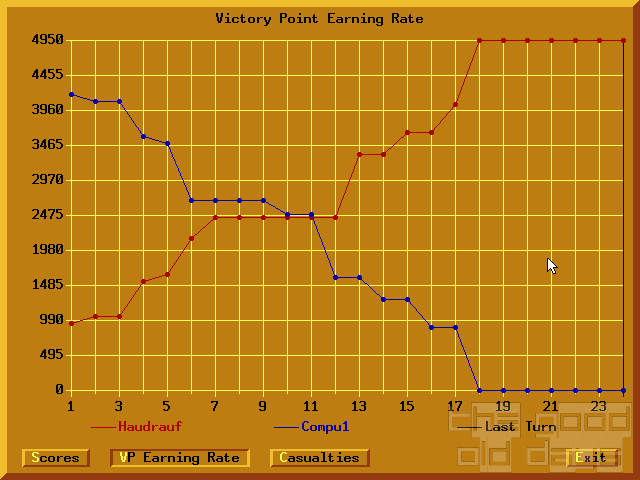
Further orgies of clicking in even more complicated situations did not appeal to me in the end. This is mainly because the level of abstraction is very high and there is too little real action. Due to the turn-based structure, the gameplay always follows the same pattern. Turn after turn, just like a board game. From this perspective, however, The Perfect General II cannot be denied its gameplay qualities, which are not diminished by the minimalist presentation. The comparison with Dune 2, however, is quite stark: While I'm playing the latest FIFA on the console, the players of The Perfect General II prefer to sit in their back room and manage the club with the Football Manager.

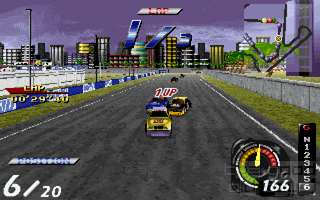
Comments (2) [Post comment]
If you've got the perfect game, why change anything? Yup, exactly. The Perfect General II is… the first game all over again. Changes are so scarce that it's almost impudent. Or bold. It's a game which makes one think how on earth they thought they could get away with it and keep face, because nothing has changed.
Virtually nothing, that is. There are few new units. An even heavier tank beyond the existing "heavy" one. An airplane which acts exactly as artillery, i.e. its attacks need to be planned one turn in advance and it is equally vulnerable to direct counterattacks. None add anything to the overall game.
It is like all those games in between which made their information less abstract never happened. No Battle Isle 2. No Panzer General.
But then, in spite of everything, you find yourself drawn in again. By the phase model requiring such complex forward thinking. By the line-of sight handling. By the different unit abilities. By pass fire opportunities during the opponent's turn. By the attacker/defender duality and the related application of the scoring system, which won't always simply declare the player who eventually manages to conquer the map the winner.
All this is because The Perfect General II changes nothing. It is a very, very good game. It is truly abysmal, despicable as a full priced release. It contains cringeworthy video clips of "military commanders" dressed up in costumes silly beyond any known standard, saying useless, painfully unfunny things. It's so good it's hard to stop playing. If you've been a veteran of the first part. Otherwise, you most certainly won't be converted.